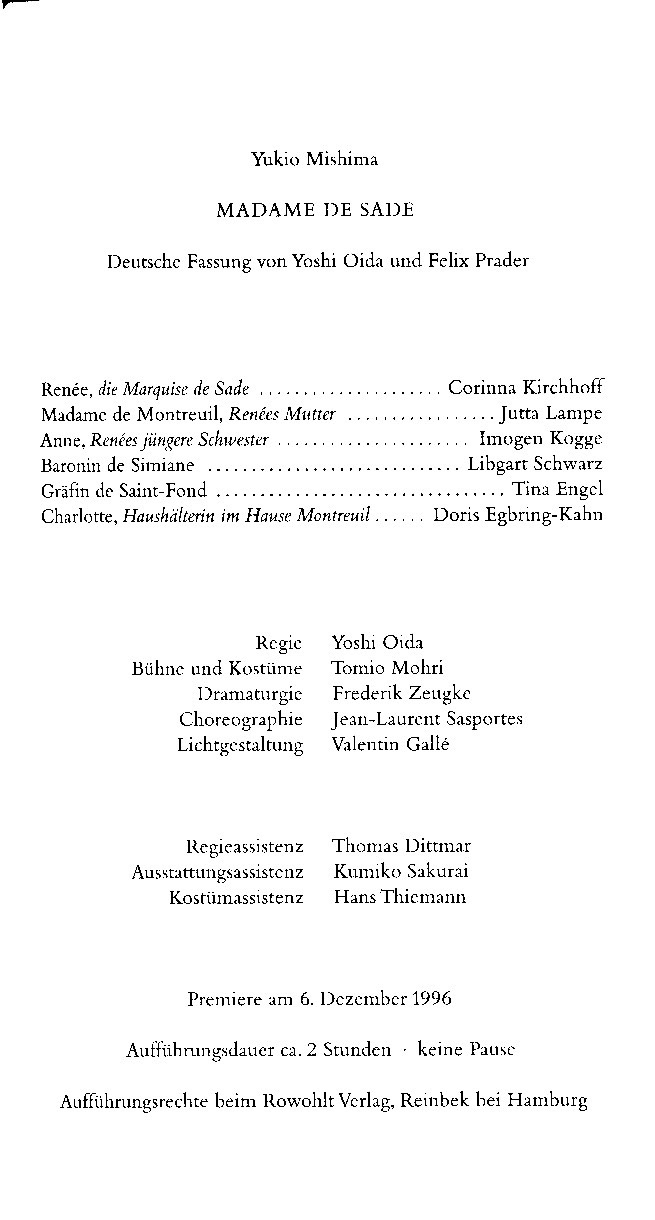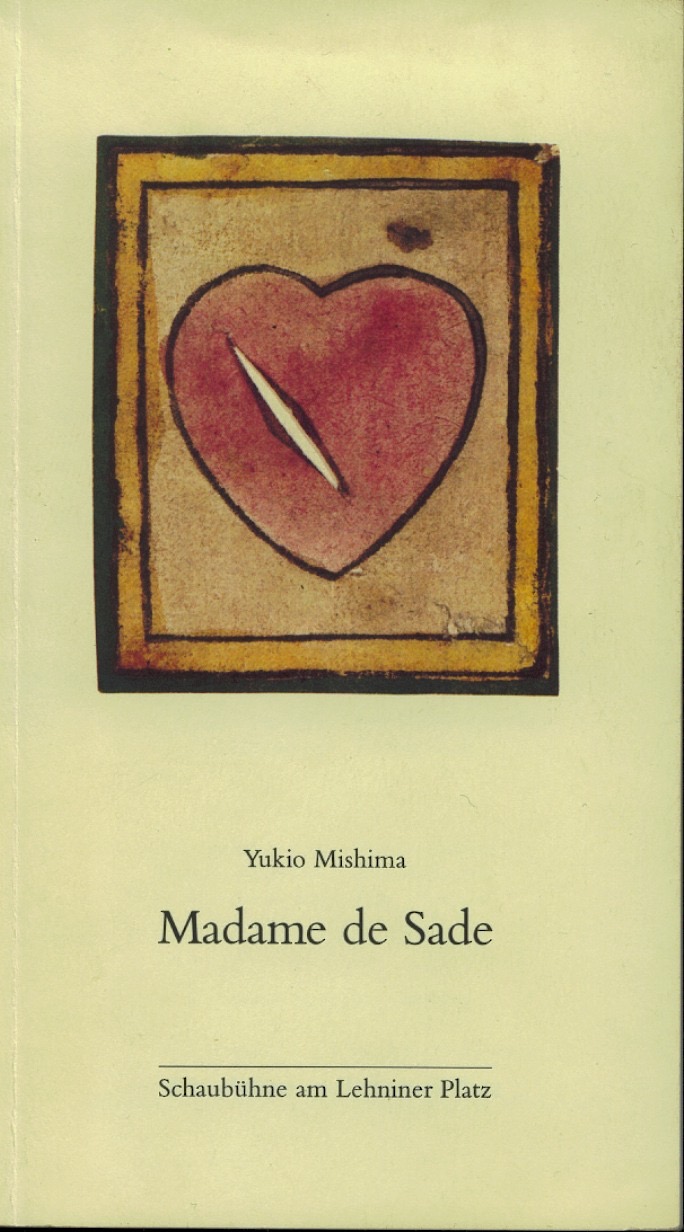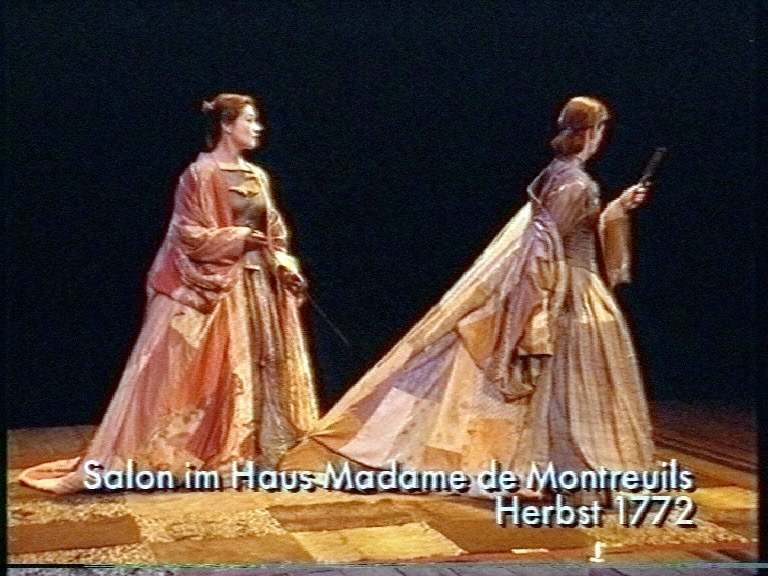
At this time, I had no idea about Yoshi´s work as stage director but, as actor, he did impressed me very much. I appreciated him form the first meeting on, very simple person, direct and friendly.
The theatre play was « Madame de Sade » written by Yukio Mishima,.
Madame de Sade is a historical fiction play written by Mishima Yukio and published in 1965. The play is based on the life of Renée de Sade, the wife of the notorious Marquis de Sade. It details the struggles of Renée, her family, and acquaintances during the Marquis various periods of incarceration. All the onstage characters are female. After reading about Marquis and Madame de Sade, Mishima questioned why Renée waited until the Marquis was finally let out of prison to leave him.
The cast was composed of five actresses which, I did not know at the time, were among the best actress that you could find in Germany. The theatre, « die Schaubühne in Berlin » where the production would be presented was also one of the most famous theatre in Germany with a legendary passed under the direction of Peter Stein.
My culture about theatre in Germany was really bad and I started this work without realising who I had the fantastic luck to work with. I imagine that it was better this way, so I could present myself more naturally.
Those five main actresses were, Jutta Lampe, Tina Engel, Libgart Schwartz, Imogen Kogge, und Corina Kirchhoff. Each of them had a long stage experience with many diverse stage directors, but still, they were used to work in a certain way which was different as Yoshi`s way.
Yoshi´s experience was based on the work that he did in Japan as actor for theatre and for movies (he played the role of Y.Mishima in a famous movie about Mishima´s life); and based also on the work that he did during many years with Peter Brook in Paris. I do not know how actors work in Japan, but I know that Peter Brook was working in a certain similar as Pina did. That means that, during the process of staging, he left a lot of room to his actors creativity; which was maybe not the way how everyone in this « Madame de Sade » production was used to work.
Another difficulty was that Yoshi who could speak perfectly, japanese of course, but also french and english, had no idea about german language. That slowly became a problem for the directing of this play which was originally in japanese, but would be performed in german language.
Finally solutions were found and, even if it needed a little time till everyone could feel comfortable with the work, after a while, harmony was there and brought its magic touch.
For me the work was a pleasure. In fact, through the European way how we understand the word « dance », I could say that there was no « danced part » in Yoshi´s staging. But in the concept of Japanese people, we should understand that, as soon as one actor is walking form a point to another, and specially for a stage entrance or way out, it is always considered as dancing. So when Yoshi was telling me:
- « Jean, at this moment, and till she or they are standing together in the middle of the stage, I need that you choreograph what is happening ».
I always understood what he meant and we never had any misunderstanding about what he was expecting from me. The « chemistry « worked right away. Yoshi and I had the same idea about what is dance and choreography for theatre. My experiences of Japan and Japanese culture helped me a lot. What a luck!.
When Yoshi said « so from this point to this point the actors will dance, it could mean that they will maybe only walk, but for a Japanese, any action that someone does on stage can be considered as dance. This was also intuitively my concept and still is in my work with all the theatre and opera directors the I work with.
I enjoyed my first step with Yoshi very much and I learned also a lot. He is a great master and his work is beautiful.
The stage scenery was similar to a Japanese Nô theatre stage, which means very empty and with long ways connecting the « out stage » to the « on stage »; no curtain and no proscenium, so a complete openness that provides a shared experience between the performers and the audience throughout the performance.
I like this stage configuration very much. It helps to better concentrate on what is happening on stage, but do not make it easy for the actors.
The simplicity of the acting, of the movements, allowed the essential to come out. I can imagine that it is not everyones taste, but it was mine and I found the result was very beautiful and strong.
(if you want to read more about "Madame de Sade")
|








